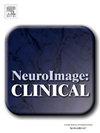Altered brain complexity in first-episode antipsychotic-naïve patients with schizophrenia: A whole-brain voxel-wise study
IF 3.6
2区 医学
Q2 NEUROIMAGING
引用次数: 0
Abstract
Background
Measures of cortical topology are believed to characterize large-scale cortical networks. Previous studies used region of interest (ROI)-based approaches with predefined templates that limit analyses to linear pair-wise interactions between regions. As cortical topology is inherently complex, a non-linear dynamic model that measures the brain complexity at the voxel level is suggested to characterize topological complexities of brain regions and cortical folding.
Methods
T1-weighted brain images of 150 first-episode antipsychotic-naïve schizophrenia (FES) patients and 161 healthy comparison participants (HC) were examined. The Chaos analysis approach was applied to detect alterations in brain structural complexity using the largest Lyapunov exponent (Lambda) as the key measure. Then, the Lambda spatial series was mapped in the frequency domain using the correlation of the Morlet wavelet to reflect cortical folding complexity.
Results
A widespread voxel-wise decrease in Lambda values in space and frequency domains was observed in FES, especially in frontal, parietal, temporal, limbic, basal ganglia, thalamic, and cerebellar regions. The widespread decrease indicates a general loss of brain topological complexity and cortical folding. An additional pattern of increased Lambda values in certain regions highlights the redistribution of complexity measures in schizophrenia at an early stage with potential progression as the illness advances. Strong correlations were found between the duration of untreated psychosis and Lambda values related to the cerebellum, temporal, and occipital gyri.
Conclusions
Our findings support the notion that defining brain complexity by non-linear dynamic analyses offers a novel approach for identifying structural brain alterations related to the early stages of schizophrenia.
首发抗精神病药物无效的精神分裂症患者大脑复杂性的改变:全脑体素研究
背景皮层拓扑的测量被认为是大规模皮层网络的特征。以往的研究采用基于感兴趣区(ROI)的方法,并使用预定义模板,将分析局限于区域之间的线性配对相互作用。由于皮层拓扑结构本身就很复杂,因此建议采用一种非线性动态模型,在体素水平上测量大脑的复杂性,以描述大脑区域和皮层折叠的拓扑复杂性。方法研究了150名首发抗精神病药物无效的精神分裂症(FES)患者和161名健康对比参与者(HC)的T1加权大脑图像。采用混沌分析方法,以最大Lyapunov指数(Lambda)为关键指标,检测大脑结构复杂性的变化。结果 在 FES 中观察到空间和频率域的 Lambda 值广泛下降,尤其是在额叶、顶叶、颞叶、边缘、基底节、丘脑和小脑区域。这种广泛的下降表明大脑拓扑复杂性和皮层折叠的普遍丧失。某些区域的 Lambda 值增加的额外模式突出了精神分裂症早期复杂性测量的重新分布,随着病情的发展,复杂性测量可能会进一步增加。结论我们的研究结果支持这样一种观点,即通过非线性动态分析来定义大脑复杂性为识别与精神分裂症早期阶段相关的大脑结构改变提供了一种新方法。
本文章由计算机程序翻译,如有差异,请以英文原文为准。
求助全文
约1分钟内获得全文
求助全文
来源期刊

Neuroimage-Clinical
NEUROIMAGING-
CiteScore
7.50
自引率
4.80%
发文量
368
审稿时长
52 days
期刊介绍:
NeuroImage: Clinical, a journal of diseases, disorders and syndromes involving the Nervous System, provides a vehicle for communicating important advances in the study of abnormal structure-function relationships of the human nervous system based on imaging.
The focus of NeuroImage: Clinical is on defining changes to the brain associated with primary neurologic and psychiatric diseases and disorders of the nervous system as well as behavioral syndromes and developmental conditions. The main criterion for judging papers is the extent of scientific advancement in the understanding of the pathophysiologic mechanisms of diseases and disorders, in identification of functional models that link clinical signs and symptoms with brain function and in the creation of image based tools applicable to a broad range of clinical needs including diagnosis, monitoring and tracking of illness, predicting therapeutic response and development of new treatments. Papers dealing with structure and function in animal models will also be considered if they reveal mechanisms that can be readily translated to human conditions.
 求助内容:
求助内容: 应助结果提醒方式:
应助结果提醒方式:


